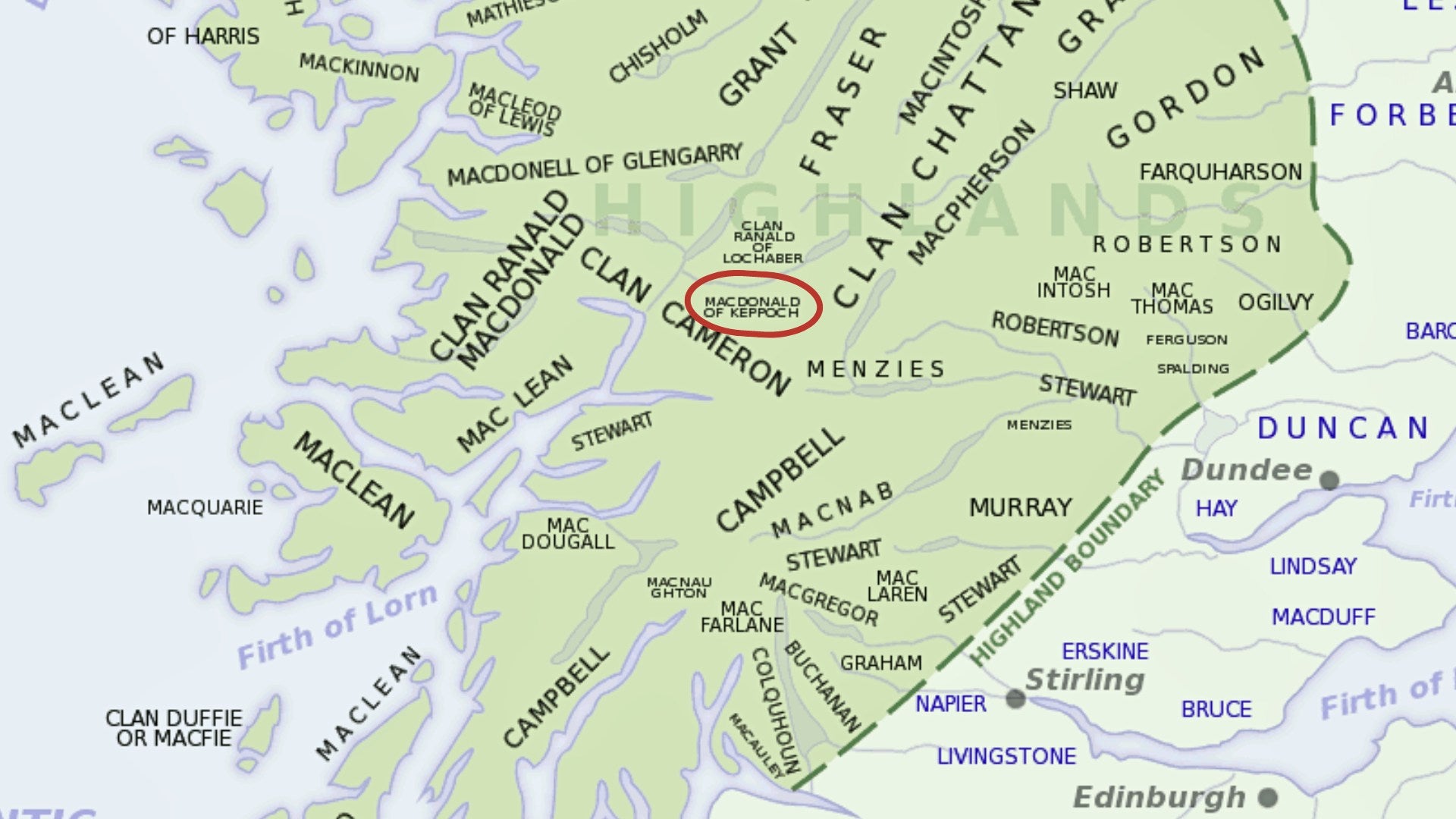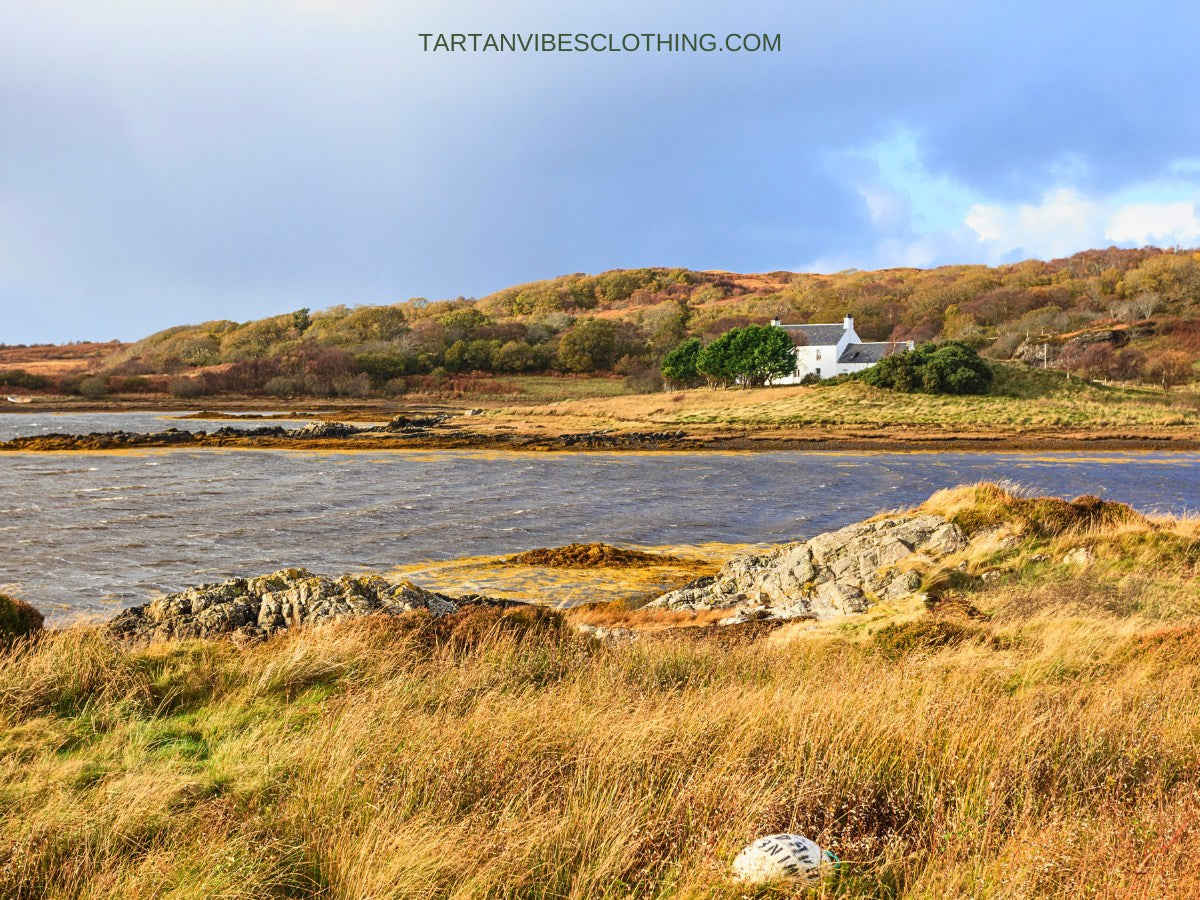Clan MacDonald of Keppoch: A Legacy of Loyalty and Culture
by Teejay Smith on Apr 27, 2024
Table of Content
Welcome to the thrilling saga of Clan Macdonald of Keppoch! Here, history intertwines with legend to weave a mesmerizing narrative. Embark on a journey through time to uncover the clan's ancient origins and enduring legacy. Explore the echoes of their traditions and delve into the annals of history to meet their legendary figures. Discover the captivating story of Clan Macdonald of Keppoch, which continues to shape their identity today.
Origins of Clan MacDonald of Keppoch
Unveiling a lineage steeped in power and Highland resilience, Clan MacDonald of Keppoch boasts ancestry linked to a legendary figure: Somerled. This formidable Norse-Gaelic leader of the 12th century earned titles like "King of the Isles" and "King of Argyll". Through strategic marriages and military prowess, Somerled wasn't just a ruler but a kingdom-builder, establishing the Kingdom of Mann and the Isles. While historians have debated his ancestry, Somerled's legacy as an influential leader is undeniable.
This foundation laid by Somerled paved the way for the rise of Clan Donald, one of Scotland's largest and most influential clans. The MacDonalds of Keppoch emerged as a proud branch of Clan Donald, and their story becomes intricately linked with the Lordship of the Isles, a powerful entity in the Scottish Highlands.
During the First War of Scottish Independence, Robert the Bruce rewarded his ally Aonghus Óg of Islay with territories including Lochaber. Aonghus Óg's unwavering loyalty and military contributions, notably at the Battle of Bannockburn in 1314, earned him the title of Lord of the Isles, cementing a lasting legacy for his lineage.
Territory of Clan MacDonald of Keppoch

The MacDonalds of Keppoch established their stronghold in the territories between Loch Linnhe and Loch Leven, including the mountainous regions of Glen Roy and Glen Spean in Inverness-shire near Spean Bridge. This strategic location in the Scottish Highlands provided natural defences and resources for the clan's sustenance and defence.
The rugged terrain of the MacDonalds' territory offered protection against outside threats while allowing the clan to maintain a watchful eye over their lands. Encompassing the MacDonald heartland, Lochaber served as a bastion of strength and a symbol of the clan's resilience in the face of adversity.
From their stronghold, the MacDonalds of Keppoch exerted influence and control over their domain, fostering a sense of unity and identity among clan members. Their territory became a centre for cultural exchange, trade and military defence, shaping the legacy of Clan MacDonald of Keppoch for generations to come.
Clan MacDonald of Keppoch History

The history of Clan MacDonald of Keppoch is a rich tapestry woven through centuries of triumphs, tragedies and enduring loyalty. From the 15th century to the present day, the story of the MacDonalds of Keppoch is one of steadfast resilience, fierce loyalty and unwavering determination.
15th Century: Origins and Challenges
16th Century: Turmoil and Feuds
The 16th century saw the MacDonalds of Keppoch embroiled in turmoil and feuds. Chief Donald Angusson MacDonald found himself at odds with the royal Scottish crown, leading to the forfeiture of his title and lands. Succession disputes and clashes with rival clans, particularly the Mackintoshes, further fueled tensions in Lochaber.
The 1663 Keppoch Murders were a brutal and tragic event that cast a long shadow over Clan MacDonald of Keppoch. Alexander MacDonald, Keppoch Tacksman of Inverlair, along with his six sons, attacked and killed the sitting Chief, Alexander MacDonald (12th of Keppoch) and his brother Ranald. Iain Lom, the Keppoch bard, became a pivotal figure in seeking revenge for the slain chiefs, highlighting the importance of upholding honour and justice within the clan.
17th Century: Loyalty and Conflict
18th Century: Jacobite Uprisings and Tragedy
19th Century to Present: Restoration and Recognition
In the 19th century, he witnessed the dormant chiefship of Clan MacDonald of Keppoch following the death of Chichester, the 21st Chief. However, in a remarkable turn of events, Ranald Alasdair MacDonald of Keppoch was acknowledged as the lawful chief by the Lyon Court in 2006 after a 30-year struggle. His descent from Donald Gorm, younger brother of the 15th Chief, was recognized, bringing a new chapter of restoration and recognition to the clan.
Through centuries of adversity and triumph, the MacDonalds of Keppoch have remained steadfast in their loyalty to their heritage and traditions. Today, their legacy lives on as a testament to the resilience of the Scottish Highlands.
📜 Please also see the history at https://www.macdonaldofkeppoch.org.uk/inaug.htm
Clan MacDonald of Keppoch Castle

Clan MacDonald of Keppoch boasts a rich history intricately linked to a formidable seat of power - Castle Keppoch. This once-mighty stronghold was located near Spean Bridge in Lochaber and witnessed centuries of clan triumphs and tragedies.
A Castle Steeped in History
Shifting Fortunes and Fierce Battles
By 1690, the tides of power shifted and Castle Keppoch fell into the hands of the rival Clan Mackintosh. This change in ownership ignited a land dispute that culminated in the last recorded clan battle fought on Scottish soil, with the grounds surrounding the castle as the battleground.
A Legacy of Resilience
A Reminder of Highland Strength
Clan MacDonald of Keppoch Coat Of Arms

The Clan MacDonald of Keppoch has a distinct coat of arms that reflects their rich history and heritage. Here's a description of the arms:
Shield: The shield is divided into four quarters, each displaying a unique symbol.
First Quarter (upper left): Displays a golden lion rampant (standing on its hind legs) with a red tongue and claws against a red background.
Second Quarter (upper right): Shows a silver armoured hand in fess (horizontal position) grasping a black cross crosslet fitchée (a cross with pointed ends) against a silver background.
Third Quarter (lower left): Depicts a black lymphad (a Viking warship) with unfurled sails and oars in action, all against a silver background.
Fourth Quarter (lower right): Showcases a silver salmon swimming horizontally in its natural colour (red) against a blue background.
Crest: Atop the shield sits a majestic golden eagle with outstretched wings, proudly wearing a ducal coronet (a crown worn by a duke).
Motto: Below the shield appears the clan motto, "Air Muir's Air Tir", which translates from Gaelic to "By Sea By Land".
The Clan MacDonald of Keppoch's coat of arms is a rich tapestry woven with symbolism. The lion roars with bravery and strength, highlighting the clan's royal lineage. A resolute armoured hand signifies their unwavering defence of justice, while the lymphad, a Viking warship, whispers of their seafaring past and potential naval prowess. The salmon, a symbol of prosperity, might represent the bounty of the local fisheries that sustained the clan. Crowning it all, a majestic eagle adorned with a ducal coronet embodies their power, sharp focus and claim to leadership within the Highlands. This powerful emblem is a timeless reminder to Clan MacDonald of Keppoch's legacy and enduring spirit.
Clan MacDonald of Keppoch Crest
Gaelic Name: MacDhomhnuill
Crest: A golden eagle spread, wearing a crown
Motto: Air Muir ‘S Air Tir (By land and by sea)
Origin of Name: Gaelic, Domhnull (World ruler)
Badge: Heath
Lands: Keppoch, Lochaber
Clan Chief: Ranald Macdonald of Keppoch

The Clan MacDonald of Keppoch's crest is a striking and symbolic element of their heraldic identity.
A Golden Eagle: The crest features a majestic golden eagle, its wings outstretched in a powerful pose. This regal bird symbolizes strength, keen vision, dominion and leadership.
Ducal Coronet: A ducal coronet crowns the eagle's head. Traditionally reserved for dukes, this elaborate crown signifies the noble lineage and high rank associated with the Clan Chief.
Combining the golden eagle and the ducal coronet creates a powerful image that reflects Clan MacDonald of Keppoch's pride in its heritage and its claim to leadership within the Highlands.
Clan MacDonald of Keppoch Tartan


The Clan MacDonald of Keppoch tartan boasts a distinctive design that sets it apart. While the exact colours may vary slightly, the most commonly cited palette features a bold interplay of red, dark green, and black. However, the tartan's history remains somewhat shrouded in mystery.
Tradition suggests the Keppoch tartan originated from a plaid Prince Charles Edward Stuart gifted to a Keppoch chief. However, the validity of this claim is disputed. Given this uncertainty, many Clan MacDonald of Keppoch members wear the widely recognized MacDonald Dress Tartan, a symbol of their broader Clan Donald heritage.
Despite the debate surrounding its origins, the Keppoch tartan remains a powerful symbol of the clan's unique identity and enduring spirit.
Unlike the patterned richness of the Clan MacDonald of Keppoch tartan, the Clan MacLean tartan exudes a distinct charm with its understated elegance. This captivating colour palette features a harmonious blend of dark green, navy blue and black, occasionally accented with red or white. This colour combination reflects the clan's rich history, where resilience and a connection to the land stand out prominently.
Explore the timeless traditions of the Clan Macdonald of Keppoch through our collection of tartan products on our website. And bring a piece of the clan's history into your present.
Notable Figures in Clan MacDonald of Keppoch

Throughout its illustrious history, Clan MacDonald of Keppoch has been blessed with remarkable individuals whose courage, leadership and accomplishments have left an indelible mark on Scottish history.
Alistair Carrach MacDonald
Regarded as the progenitor of Clan MacDonald of Keppoch, Alistair Carrach MacDonald played a pivotal role in establishing the clan's legacy. As the third son of John of Islay, Lord of the Isles, Alistair Carrach MacDonald inherited the Lordship of Lochaber, laying the foundation for the MacDonalds of Keppoch to flourish in the centuries to come.
Alexander MacDonald, 17th of Keppoch

A stalwart defender of Jacobite principles, Alexander MacDonald, 17th of Keppoch, distinguished himself during the Jacobite rising of 1745. Leading his men into battle at the Highbridge Skirmish and the siege of Fort William, Alexander demonstrated unwavering loyalty and bravery in the face of adversity, ultimately sacrificing his life for the Jacobite cause at the Battle of Culloden.
Ranald Alasdair MacDonald of Keppoch

Coll MacDonald, 16th of Keppoch
A fierce defender of his clan's honour and dignity, Coll MacDonald, 16th of Keppoch, faced persecution and imprisonment at the hands of his enemies. Despite enduring great hardship and adversity, Coll MacDonald remained resolute in his determination to uphold the traditions and values of Clan MacDonald of Keppoch, inspiring future generations to follow in his footsteps.
Iain Lom or John MacDonald (c. 1624 – c. 1710)
He was a multifaceted figure in Clan MacDonald of Keppoch's history. He was a skilled bard, a fierce warrior, and a passionate keeper of clan traditions. Iain Lom 's Gaelic war poetry stirred the hearts of his clan members. At the same time, his unwavering loyalty and determination to seek justice for the slain chiefs in the Keppoch Murders cemented his status as a clan hero. He also played a crucial role in preserving the clan's history and traditions through his poems and songs.
Iain Lom's contributions earned him the respect of his clan. They secured him a place of honour as the first Poet Laureate of Scotland appointed by King Charles II. He remains a revered figure in Clan MacDonald of Keppoch's legacy.
Conclusion
In summary, Clan MacDonald of Keppoch epitomizes the rich tapestry of Scottish history, with roots tracing back through the annals of time. From their humble beginnings in Lochaber to their enduring presence in the Highlands, the MacDonalds of Keppoch have exemplified resilience, grit and a profound connection to their ancestral lands.
Beyond their bravery on the battlefield, the MacDonalds of Keppoch have left an indelible mark on Scotland's cultural heritage, contributing significantly to music, poetry and craftsmanship. Their tartan, with its vibrant colours and intricate design, symbolises pride and identity for clan members worldwide.
Today, the global network of Clan MacDonald of Keppoch societies stands as a beacon of unity, fostering camaraderie and solidarity among the clan's descendants. Through gatherings, celebrations and the preservation of traditions, these societies ensure that the legacy of the MacDonalds of Keppoch endures for generations to come, a testament to the clan's enduring spirit.
Frequently Asked Questions
Who is the Clan Macdonald of Keppoch?
The MacDonalds of Keppoch are one of the branch clans of Clan Donald—one of the largest Scottish clans. The eponymous ancestor of Clan Donald is Donald, son of Reginald, son of Somerled.
What are the origins of Clan MacDonald of Keppoch?
Today, the global network of Clan MacDonald of Keppoch societies stands as a beacon of unity, fostering camaraderie and solidarity among the clan's descendants. Through gatherings, celebrations, and the preservation of traditions, these societies ensure that the legacy of the MacDonalds of Keppoch endures for generations to come, a testament to the clan's enduring spirit.
Where was the territory of Clan MacDonald of Keppoch?
Their stronghold was located in the Scottish Highlands, between Loch Linnhe and Loch Leven, encompassing Glen Roy, Glen Spean and Lochaber. This strategic location offered both natural defences and resources for the clan.
What is Clan MacDonald of Keppoch's castle?
Castle Keppoch served as their ancestral home for generations. It witnessed their triumphs and tragedies, changing hands between clans and even enduring the Keppoch Murders within its walls. While now a ruin, it stands as a symbol of the clan's resilience.











